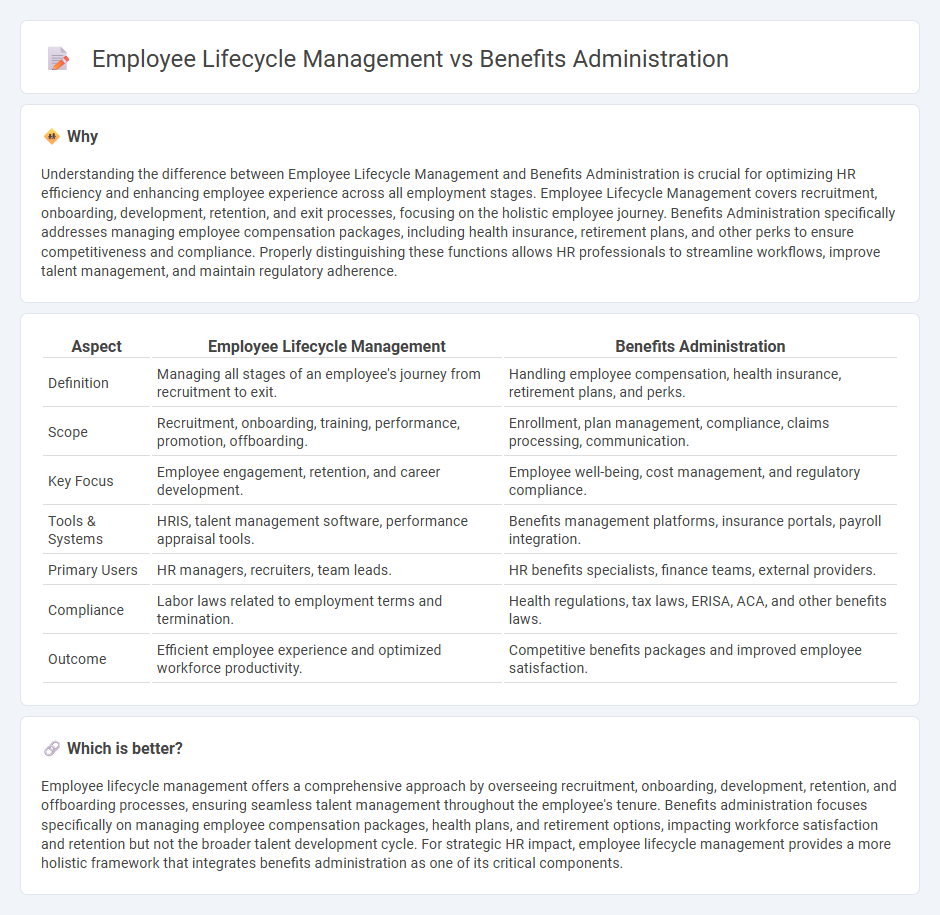
Employee lifecycle management encompasses the entire journey of an employee from recruitment to exit, focusing on talent acquisition, onboarding, development, and offboarding processes. Benefits administration specifically handles the management, enrollment, and communication of employee benefits such as health insurance, retirement plans, and wellness programs. Explore in-depth how integrating these functions can optimize workforce efficiency and employee satisfaction.
Why it is important
Understanding the difference between Employee Lifecycle Management and Benefits Administration is crucial for optimizing HR efficiency and enhancing employee experience across all employment stages. Employee Lifecycle Management covers recruitment, onboarding, development, retention, and exit processes, focusing on the holistic employee journey. Benefits Administration specifically addresses managing employee compensation packages, including health insurance, retirement plans, and other perks to ensure competitiveness and compliance. Properly distinguishing these functions allows HR professionals to streamline workflows, improve talent management, and maintain regulatory adherence.
Comparison Table
| Aspect | Employee Lifecycle Management | Benefits Administration |
|---|---|---|
| Definition | Managing all stages of an employee's journey from recruitment to exit. | Handling employee compensation, health insurance, retirement plans, and perks. |
| Scope | Recruitment, onboarding, training, performance, promotion, offboarding. | Enrollment, plan management, compliance, claims processing, communication. |
| Key Focus | Employee engagement, retention, and career development. | Employee well-being, cost management, and regulatory compliance. |
| Tools & Systems | HRIS, talent management software, performance appraisal tools. | Benefits management platforms, insurance portals, payroll integration. |
| Primary Users | HR managers, recruiters, team leads. | HR benefits specialists, finance teams, external providers. |
| Compliance | Labor laws related to employment terms and termination. | Health regulations, tax laws, ERISA, ACA, and other benefits laws. |
| Outcome | Efficient employee experience and optimized workforce productivity. | Competitive benefits packages and improved employee satisfaction. |
Which is better?
Employee lifecycle management offers a comprehensive approach by overseeing recruitment, onboarding, development, retention, and offboarding processes, ensuring seamless talent management throughout the employee's tenure. Benefits administration focuses specifically on managing employee compensation packages, health plans, and retirement options, impacting workforce satisfaction and retention but not the broader talent development cycle. For strategic HR impact, employee lifecycle management provides a more holistic framework that integrates benefits administration as one of its critical components.
Connection
Employee lifecycle management and benefits administration are interconnected through the seamless integration of onboarding, performance tracking, and offboarding processes with benefits enrollment and management. Effective lifecycle management ensures timely communication of benefits eligibility, changes, and renewals aligned with each stage of the employee journey. This integration enhances employee satisfaction and compliance by maintaining accurate benefits data throughout hiring, development, and separation phases.
Key Terms
**Benefits administration:**
Benefits administration involves managing employee health insurance, retirement plans, and wellness programs to ensure compliance and optimize enrollment processes. It enhances employee satisfaction by providing clear communication and streamlined access to benefits while reducing administrative costs for organizations. Explore more to understand how effective benefits administration can improve workforce engagement and retention.
Health Insurance
Health insurance administration within benefits management ensures precise enrollment, timely claims processing, and adherence to regulatory compliance, enhancing employee satisfaction and reducing organizational risk. Employee lifecycle management integrates health insurance benefits from onboarding through offboarding, promoting continuity of coverage and personalized health care support at each employment stage. Explore how these strategies optimize employee health benefits and streamline administrative efficiency.
Retirement Plans
Benefits administration specifically manages retirement plans by handling plan enrollment, contributions, and compliance with regulatory requirements such as ERISA and IRS guidelines. Employee lifecycle management encompasses retirement as one phase, integrating retirement planning with talent development, succession planning, and offboarding processes. Explore the key differences to optimize your organization's approach to managing retirement benefits effectively.
Source and External Links
What Is Benefits Administration? Benefits and Process | Paycom Blog - Benefits administration is the process of evaluating, selecting, managing, and enrolling employees in an organization's benefits program, ensuring compliance with laws and meeting employee needs through continuous engagement and feedback analysis.
What Is Benefits Administration? - Paycor - It involves creating and maintaining employee benefits programs like health insurance, retirement plans, and paid leave, which helps attract and retain talent, ensures legal compliance, and improves employee well-being and productivity.
Employee Benefits Administration and Outsourcing - Paychex - Benefits administration includes managing employee benefits programs, ensuring compliance with laws such as ERISA, and communicating effectively with employees to protect their rights and maintain transparency.
 dowidth.com
dowidth.com